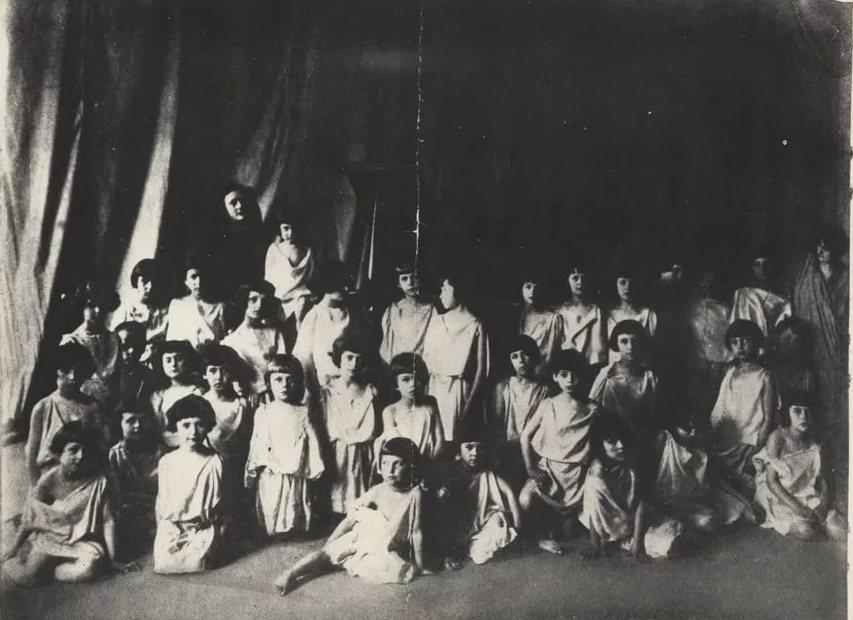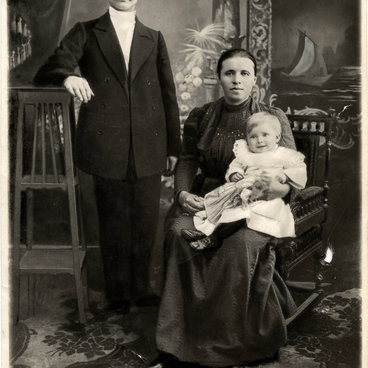The photograph was taken at the Balashov mansion on Prechistenka on the day of the marriage of Sergei Esenin and Isadora Duncan, which took place on the 2nd of May 1922. Ilya Schneider, a journalist and theatre worker who helped Duncan organise her dancing school, recalled: ‘Both of them decided to register their marriage under Soviet law, especially as they were to travel to America and Isadora knew the ways of the local vice police very well… At early sunny morning, the three of us set off to the Khamovniki registry office, which was next door to us in one of the Prechistenka lanes. The registry office was grey and clerical. When asked what surname they were choosing, they both wished to have the double surname Duncan-Esenin.
The day before, Isadora approached me embarrassedly, holding her French “passport” in her hands.
- Could you change it a little? — Even more embarrassed, she asked.
I did not understand. Then she touched a number on the year of her birth. I laughed — Isadora was standing in front of me, so beautiful, slim, slimmer and younger, much better than the Isadora Duncan I had first seen in Gelzer’s flat about a year before.
But she stood before me, smiling shyly and closing her finger on the number of the year of her birth, written in black ink… ‘.
Leaving the registry office, Esenin shouted joyfully: “Now I am a Duncan.” Soon they were travelling abroad. At the end of that journey, their marriage ended.
Also pictured is Irma Duncan, Isadora’s adopted daughter, a dancer and dance teacher. After Isadora Duncan left for Europe in 1924, Irma took over the school in Moscow and worked there until 1930.
Her mother brought seven-year old Irma to audition for the dancer Isadora Duncan in January 1905. In 1917 she and five other students of Isadora changed their names to Duncan and became adopted daughters of the dancer. After the school toured the United States, Irma decided to remain in America. Duncan’s dance studio in Moscow existed for 18 years after her departure and was liquidated in 1948 as part of the fight against cosmopolitanism.
The day before, Isadora approached me embarrassedly, holding her French “passport” in her hands.
- Could you change it a little? — Even more embarrassed, she asked.
I did not understand. Then she touched a number on the year of her birth. I laughed — Isadora was standing in front of me, so beautiful, slim, slimmer and younger, much better than the Isadora Duncan I had first seen in Gelzer’s flat about a year before.
But she stood before me, smiling shyly and closing her finger on the number of the year of her birth, written in black ink… ‘.
Leaving the registry office, Esenin shouted joyfully: “Now I am a Duncan.” Soon they were travelling abroad. At the end of that journey, their marriage ended.
Also pictured is Irma Duncan, Isadora’s adopted daughter, a dancer and dance teacher. After Isadora Duncan left for Europe in 1924, Irma took over the school in Moscow and worked there until 1930.
Her mother brought seven-year old Irma to audition for the dancer Isadora Duncan in January 1905. In 1917 she and five other students of Isadora changed their names to Duncan and became adopted daughters of the dancer. After the school toured the United States, Irma decided to remain in America. Duncan’s dance studio in Moscow existed for 18 years after her departure and was liquidated in 1948 as part of the fight against cosmopolitanism.




